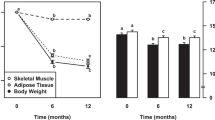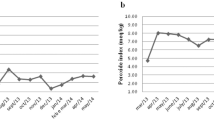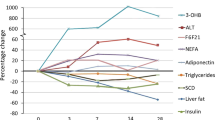Abstract
OBJECTIVE: To investigate possible relationships between leptin and energy expenditure (EE), both in the condition of stable body weight and during weight loss.
SUBJECTS: Seventy four Caucasian, adult obese women with stable body weight (including 10 obese women studied before and during a body weight-reducing program).
MEASUREMENTS: Resting EE (REE) and substrate oxidation rates by indirect calorimetry; plasma leptin concentrations by radioimmunoassay (RIA).
RESULTS: In conditions of stable body weight, leptin values showed a significant, negative relationship with REE, as expressed in absolute values (P=0.030) and as adjusted for the variation in lean body mass (LBM) (P=0.017). This negative relationship was independent of both LBM and fat mass (FM). Linear regression analysis was used to obtain the equation linking REE and LBM; then both predicted REE and the percent deviation from predicted REE were calculated for each subject. Leptin values were negatively related (P<0.0001) to the deviation from predicted REE. During active body weight loss, the modifications of both REE (Δ REE) and lipid oxidation (Δ lipid oxidation) were significantly negatively related to leptin concentrations, which were measured before the dieting period (P<0.03 for both).
CONCLUSION: In obese women, high plasma leptin concentrations are associated with a low rate of REE, when body weight is stable, and with a reduction of REE and lipid oxidation, in response to a hypocaloric diet. This suggests that, in severely obese women, leptin is a marker of sparing energy mechanisms operating in both basal and reducing weight conditions.
This is a preview of subscription content, access via your institution
Access options
Subscribe to this journal
Receive 12 print issues and online access
$259.00 per year
only $21.58 per issue
Buy this article
- Purchase on Springer Link
- Instant access to full article PDF
Prices may be subject to local taxes which are calculated during checkout
Similar content being viewed by others
Author information
Authors and Affiliations
Rights and permissions
About this article
Cite this article
Bobbioni-Harsch, E., Assimacopoulos-Jeannet, F., Lehmann, T. et al. Leptin plasma levels as a marker of sparing-energy mechanisms in obese women. Int J Obes 23, 470–475 (1999). https://doi.org/10.1038/sj.ijo.0800843
Received:
Revised:
Accepted:
Published:
Issue Date:
DOI: https://doi.org/10.1038/sj.ijo.0800843
Keywords
This article is cited by
-
Leptin Levels Are Associated with Fat Oxidation and Dietary‐Induced Weight Loss in Obesity
Obesity Research (2001)
-
Plasma leptin concentrations, basal metabolic rates and respiratory quotients in young and older adults
International Journal of Obesity (2000)



